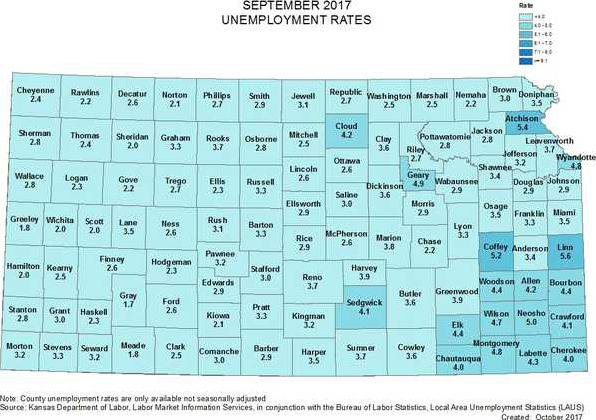TOPEKA — Despite hurricanes that impacted national jobless numbers, Kansas employment remains robust, the Kansas Department of Labor reported Friday.
Preliminary estimates reported by the KDL and Bureau of U.S. Labor Statistics show a seasonally adjusted unemployment rate of 3.8 percent in September, down from 3.9 percent in August and down from 4.3 percent in September 2016.
In Barton County, the jobless rate was 3.3 percent in September with 471 unemployed. It was 3.9 percent in August with 559 unemployed, and 4.3 percent in September 2016.
“Kansas maintained a healthy labor market in September with the unemployment rate falling to 3.8 percent and employers adding a significant number of private sector jobs,” said Kansas Secretary of Labor Lana Gordon.
Seasonally adjusted job estimates indicate total Kansas nonfarm jobs increased by 5,000 from August. Private sector jobs, a subset of total nonfarm jobs, increased by 5,500 from the previous month.
“Kansas City and Wichita gained a significant number of jobs over the month, and Kansas posted an overall significant gain in private sector jobs from August to September by adding 5,500 jobs statewide,” said senior labor economist Tyler Tenbrink. “While this represents a notable improvement from the pace of job growth experienced so far this year, approximately 5,000 additional jobs will be needed to get back to positive growth over the year.”
Since September 2016, Kansas lost 5,100 seasonally adjusted total nonfarm jobs and 5,000 private sector jobs.
BLS revised seasonally adjusted preliminary total nonfarm job estimates for August upward by 3,600 jobs, from 1,401,900 to 1,405,500. Seasonally adjusted private sector jobs were revised downward by 400 jobs, from 1,149,000 to 1,148,600.
According to the BLS, unemployment rates were lower in September in 11 states, higher in four states, and stable in 35 states and the District of Columbia.
Overall nationally, according to the BLS, the unemployment rate declined to 4.2 percent in September, and total nonfarm payroll employment changed little (-33,000). A sharp employment decline in food services and drinking places and below-trend growth in some other industries likely reflected the impact of hurricanes Irma and Harvey.





